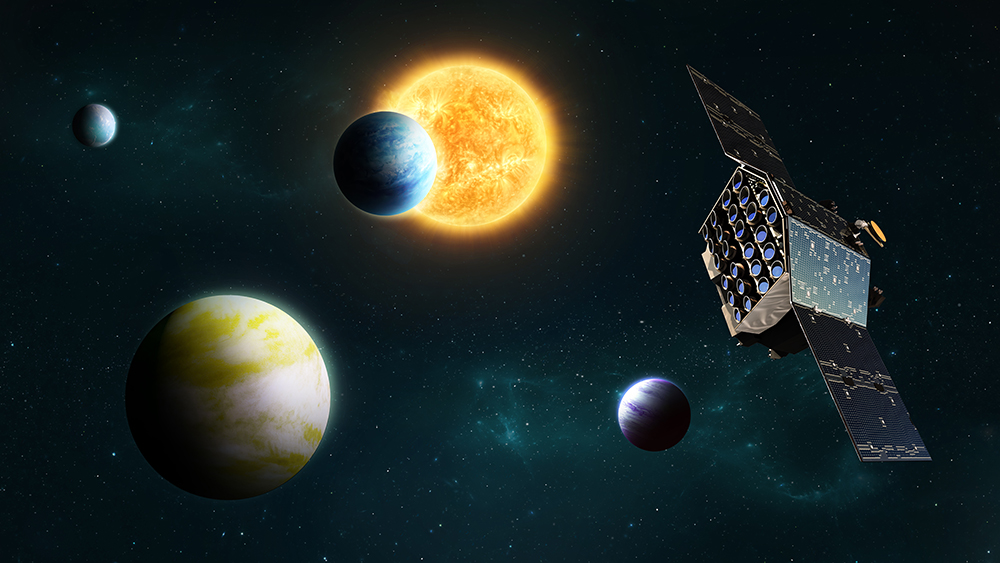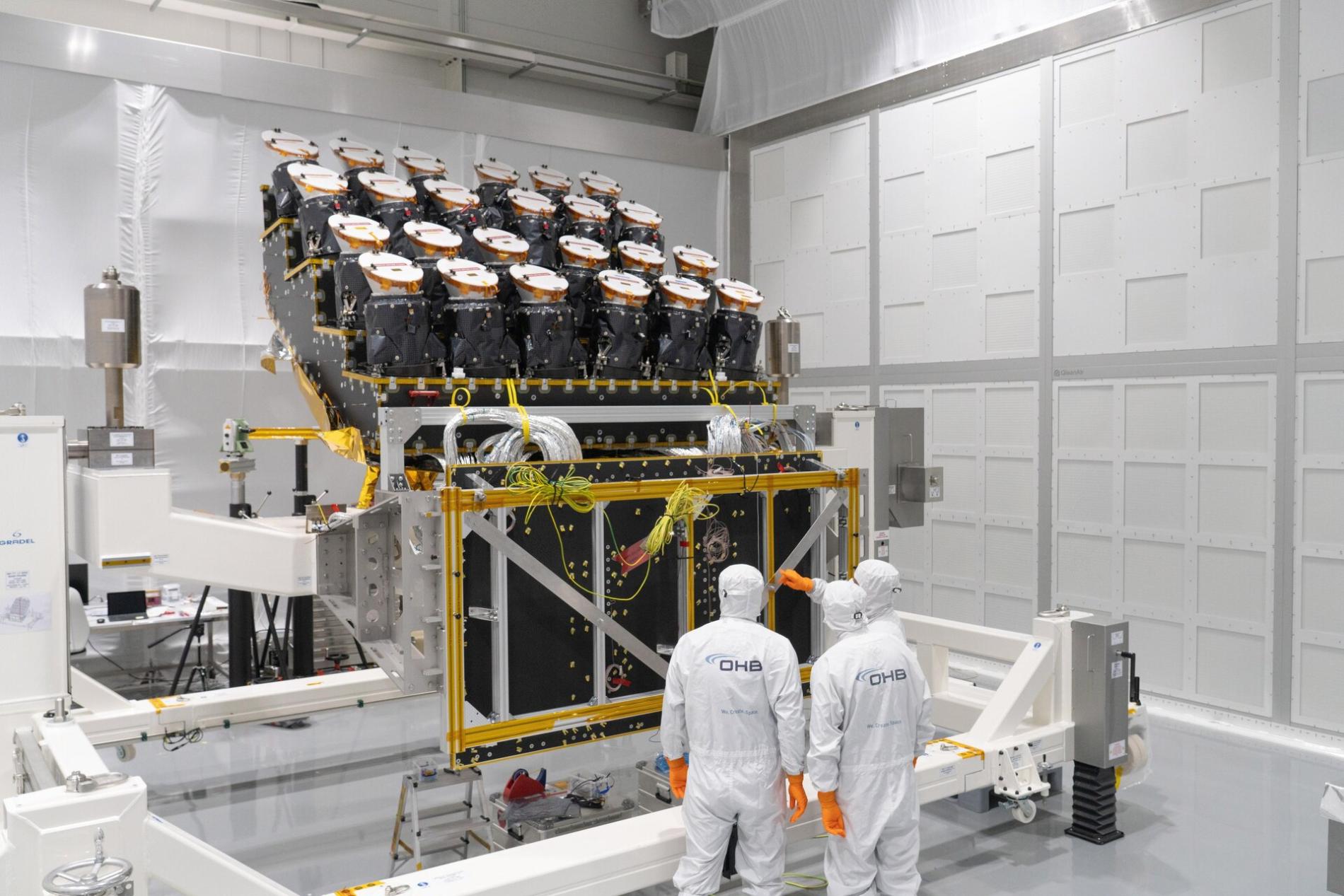ESA's PLATO space telescope completes key phase in its search for exoplanets
The integration of the telescope’s two main components at OHB facilities in Oberpfaffenhofen (Germany) marks a decisive step for the mission
The Instituto de Astrofísica de Andalucía (IAA-CSIC) plays a prominent scientific and technological role in this milestone and throughout the mission
Are there planets like Earth? Do they orbit stars similar to the Sun? How do planetary systems form and evolve? To address these and other fundamental questions, the European Space Agency (ESA) will launch the PLATO 2.0 mission (PLAnetary Transits and Oscillations of stars) in late 2026. Starting in 2027, PLATO will begin its exploration of planets beyond our Solar System, with a special focus on Earth-sized worlds orbiting Sun-like stars.
Over the past 15 years, high-precision space photometry missions developed by major space agencies have driven significant progress in stellar physics and exoplanet science. In this context, the pioneering PLATO 2.0 mission has been designed to discover potentially habitable planets around stars similar to our Sun. Its goal is to study thousands of exoplanets in detail, with a particular interest in Earth-like — rocky, silicon-oxygen-metal-based — planets, as opposed to gas giants like Jupiter or Saturn.

Artist's impression of ESA's PLATO mission. Credits: ESA
“Thanks to its large field of view and unprecedented precision, PLATO will be able to characterize Earth-like exoplanets and lay the scientific groundwork for understanding our place in the universe,” says Dr. Javier Pascual, head of the Stellar Variability Group at the Instituto de Astrofísica de Andalucía (IAA-CSIC) and a member of the PLATO Spain consortium.
In June 2025, the PLATO mission reached a major milestone: the integration of the two main components of its telescope was completed at the aerospace and technology company OHB’s facilities in Oberpfaffenhofen, Germany.
“Almost eight years after ESA gave the green light to PLATO, both the satellite and its unique 26-eyed telescope have been completed as planned,” notes Heike Rauer, the mission’s science lead from DLR and Freie Universität Berlin. “This is a remarkable achievement. Unlike many other space telescopes, PLATO does not rely on a single complex camera but operates with a suite of 26 cameras in total.”
This innovative system will enable PLATO to observe some 250,000 stars in search of orbiting planets. The cameras have been built and tested by various member countries of the PLATO Mission Consortium (PMC). “International cooperation between the PMC and ESA has been exemplary. All tests so far indicate that PLATO will reach the planned and required measurement precision,” adds Rauer.
A KEY STEP BEFORE LAUNCH
At the OHB facilities in Bavaria, PLATO has successfully completed one of the most delicate phases of the mission: the integration of the 26 scientific cameras and the bench housing all the electronics for data acquisition, processing, and control. The cameras were first assembled on an optical platform and then precisely mounted — to within millimeters — on the spacecraft's service module, which contains systems for control, propulsion, communication, and data management.
After carefully aligning both structures and verifying all electrical and communication connections, the technical team permanently joined the telescope to the service module. In the coming weeks, the spacecraft will undergo full functional tests to ensure proper operation of the telescope and its data processing systems.
The next step will be its transfer to ESA’s European Space Research and Technology Centre (ESTEC) in the Netherlands, where the solar panels and thermal shields will be installed. Afterwards, PLATO will be tested under space-like conditions before being shipped to Kourou (French Guiana) for launch aboard an Ariane 6 rocket in December 2026.

Engineers from OHB, Germany, inspect the cameras installed on the optical bench of the PLATO spacecraft. Credits: ESA – P. Sebirot
SPAIN’S CONTRIBUTION TO THE PLATO MISSION
Spain plays a key role in the PLATO mission, both technologically and scientifically. Spain is involved in the development of the onboard computers that will process all images and scientific data, led by the Instituto de Astrofísica de Andalucía (IAA-CSIC); in the thermo-mechanical structures of the telescope’s 26 cameras, developed by the Centro de Astrobiología (CAB-CSIC/INTA); and in the thermal vacuum calibration of ten of these cameras, carried out by the Instituto Nacional de Técnica Aeroespacial (INTA). Spain is also contributing to the development and implementation of innovative tools for ground-based data processing, analysis and treatment of the information that the satellite will generate over the four years following its launch.
On the scientific side, the Stellar Variability Group at the Instituto de Astrofísica de Andalucía (IAA-CSIC) plays a prominent role in the mission’s preparation. Their work focuses on developing advanced data analysis techniques, high-precision stellar models and artificial intelligence to interpret PLATO’s vast data output and generate theoretical models of stars and planets. The team also advocates for open science, promoting full accessibility, clarity and reproducibility of data, codes, methods and protocols for the global scientific community.
Meanwhile, the Instrumental and Technological Development Unit (UDIT) at the Instituto de Astrofísica de Andalucía (IAA-CSIC) is responsible for the design and development of the telescope’s two main electronic units, known as MEUs (Main Electronic Units). Each MEU integrates six processing computers (NDPUs), two SpaceWire routers for space environments, and the corresponding power supply units (MEU-PSUs), the latter developed by a team at the Instituto de Astrofísica de Canarias (IAC).
UDIT’s work spans all phases of development: from the first prototypes and structural models built in the IAA-CSIC laboratories to the engineering and qualification models. The two final models that will fly in 2026 were built by Thales Alenia Space España, while the MEU-PSUs were manufactured by AIRBUS-CRISA.

The two main electronics units of the PLATO telescope (MEU). On the right, MEU #1 and on the left, MEU #2. Credits: OHB-ESA
Each MEU receives data from 24 of PLATO’s main cameras—two per NDPU—processes the images, and sends them to the instrument’s central computer, where they are losslessly compressed before transmission to Earth.
Achieving this efficiency posed one of the mission’s key technological challenges: making each MEU—comprising six computers processing data from thousands of stars in near real time—operate on less than 17 watts, equivalent to a household light bulb, and weigh under 11 kilograms including its protective housing against intense space radiation.
“We’ve been working on PLATO’s MEUs for more than ten years, and finally seeing the instrument assembled and operational after so much collective effort is immensely satisfying. It’s a moment of joy and pride that will only be surpassed by launch day and the first operations in space. Additionally, we’ve built a highly experienced team that will enable us to tackle new challenges in future space missions,” says Dr. Julio Rodríguez Gómez, principal investigator and responsible for the PLATO MEUs at the Instituto de Astrofísica de Andalucía (IAA-CSIC).
The consorcio PLATO España is made up of seven leading research centres: Instituto de Astrofísica de Andalucía (IAA-CSIC), Instituto de Astrofísica de Canarias (IAC-CSIC), Centro de Astrobiología (CAB-CSIC/INTA), Instituto Nacional de Técnica Aeroespacial (INTA), Instituto de Ciencias del Espacio (ICE-CSIC), Universidad de Granada (UGR), and Universidad de Valencia (UV).
26 CAMERAS SCANNING THE MILKY WAY
Thanks to its unique design—with 26 cameras mounted on a common platform—the PLATO mission will observe around 250,000 stars in search of orbiting planets. To achieve this, it will be sent to the Sun-Earth Lagrange point L2, located 1.5 million kilometres from Earth, where the James Webb Space Telescope is also stationed.
PLATO is expected to discover thousands of new worlds—rocky, icy, and gaseous—orbiting various types of stars. It will use the transit method, detecting tiny, periodic dips in a star’s brightness caused by a planet passing in front of it.
Once these candidates are identified, they will be studied in more detail from Earth using complementary observations and other techniques, such as radial velocity measurements, which allow scientists to determine a planet’s mass and confirm its existence.
- Javier Pascual Granado- javier@iaa.es
- Julio Rodríguez Gómez - julio@iaa.es
- Sebastiano de Franciscis (Responsable de Comunicación del Consorcio Plato España) - sebas@iaa.csic.es
- Instituto de Astrofísica de Andalucía (IAA-CSIC)
- Unidad de Divulgación y Comunicación
- Amanda López – alm@iaa.es
- Emilio García – garcia@iaa.es - 649 407 445 (vía whatssap)
- Celia Navas - navas@iaa.es
- https://www.iaa.csic.es
- https://divulgacion.iaa.csic.es

